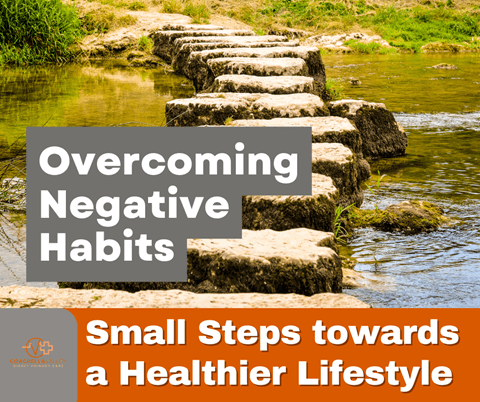Ever find yourself circling back to square one, like a well-worn path in your backyard that’s been treaded too many times? That’s the dance of Behavior Change. Think about it: when was the last time you promised to swap out those bad habits for some shiny new healthy ones?
You’re not alone. Every year, countless folks pledge to quit smoking or start eating better—sound familiar? But let’s get real; how often does that determination fizzle out faster than a sparkler on the Fourth of July?
We’ve all been there, staring down at our sneakers before taking that first daunting jog around the block. It’s a journey—a marathon, not a sprint—with its fair share of stumbles and restarts.
The secret sauce? Knowing where you stand in this change-making tango can be game-changing. And guess what—I’m here to guide you through each step with insights as fresh as morning dew.
Take a sec to relax; the journey’s only just begun.
Coachella Valley Direct Primary Care
Frustration-free health care for the whole family. A monthly membership program designed for the busy Coachella Valley family to give you direct access to primary healthcare services so you can be healthy and active. Schedule a free consultation. 760-642-5549

Table Of Contents:
- Coachella Valley Direct Primary Care
- Understanding the Transtheoretical Model of Behavior Change
- Precontemplation Stage: Unawareness of Problem Behavior
- Contemplation Stage: Recognizing the Need for Change
- Preparation Stage: Planning for Healthy Behaviors
- Action Stage: Implementing Changes to Behavior
- Real-World Change Examples and Coping Strategies
- Smoking Cessation Success Stories
- Overcoming Negative Habits with Small Steps
- The Role of Social Support in Changing Behavior
- Building a Support System for Health Promotion
- Seeking Professional Help When Needed
- Long-Term Success in Behavioral Change Interventions
- The Importance of Continual Consciousness Raising
- Finding Your Tribe: Social Support Networks
- Conclusion
- Coachella Valley Direct Primary Care
Understanding the Transtheoretical Model of Behavior Change
Ever felt like a hamster on a wheel when trying to kick a bad habit? That’s where the transtheoretical model comes in, breaking down the journey into manageable chunks. Created by researchers James Prochaska and Carlo DiClemente, this change model has been an ace up public health’s sleeve for decades.
Precontemplation Stage: Unawareness of Problem Behavior
Sometimes we’re blind to our own problem behaviors. It’s like having spinach stuck in your teeth but no mirror—or friend—to tell you it’s there. The precontemplation stage is just that; folks don’t even see their current behavior as an issue, so why fix what isn’t broken?
In this phase, negative consequences are often invisible or ignored because let’s face it – ignorance can be bliss. But not forever.
Contemplation Stage: Recognizing the Need for Change
Aha. The moment you realize that spinach has been chilling between your teeth all day long—that’s contemplation for you. Suddenly people start weighing pros and cons more than they did at any earlier stages of behavior change—like considering quitting smoking after years of lighting up without batting an eyelid.
This is when individuals begin consciousness raising, understanding how much better life could be sans bad habits—and yes, with clean teeth too.
Preparation Stage: Planning for Healthy Behaviors
You’ve got floss now; time to plan those moves against unwanted behaviors. In preparation action maintenance terms – well actually just ‘preparation’ here – people get ready mentally and physically for positive changes ahead.
The key stat? Most who skip this planning bit tend to fall flat faster than saying ‘transtheoretical’. So buckle up.
Action Stage: Implementing Changes to Behavior
The rubber meets the road when plans turn into real-life actions—it’s go-time. This stage is all about making those shifts happen; think swerving from junk food towards salads or swapping Netflix binges with jogs around the block.
Tough? Sure. Worthwhile? Absolutely.
Key Takeaway:
Ditch bad habits with the transtheoretical model: Recognize your blind spots, weigh the pros and cons, plan your attack, take action, and keep it up to avoid a relapse. It’s about seeing clearly, prepping smartly, making moves, and sticking to them.
Real-World Change Examples and Coping Strategies
Smoking Cessation Success Stories
Chat with someone who’s stopped smoking successfully, and they’ll explain the ups and downs of transformation. It’s not just a habit; it’s an old friend that has overstayed its welcome. These people have moved through every twist and turn of the transtheoretical model stages, from not seeing a problem (precontemplation) to considering their health (contemplation), all the way to taking action and keeping up with maintenance.
In these stories, we see folks raising their consciousness repeatedly because let’s face it – old habits die hard. They remind themselves why they started this journey: for better health, more energy, or perhaps family reasons. Some found success by preparing alternatives like nicotine gum or patches during the preparation stage while others leaped straight into action with sheer willpower. But ask them how they avoid relapse now in maintenance mode. Many will point towards coping strategies like exercise or meditation as their saving grace.
Overcoming Negative Habits with Small Steps

Making change isn’t always about grand gestures; sometimes it’s the small steps that lead us down new paths. Researchers James Prochaska and Carlo DiClemente didn’t come up with those fancy stages—like contemplation, preparation, action, maintenance, and termination—for nothing. The key is understanding that behavior change occurs incrementally.
Say someone wants to get healthier but loves junk food—a common negative habit among many. They might start by swapping out one snack at a time rather than overhauling their entire diet overnight which aligns perfectly with what we call ‘small steps.’ This gradual approach can build confidence as each tiny victory adds up—and before you know it, positive behaviors replace bad ones without overwhelming our brains.
The evidence shows us maintaining changes gets easier over time too—the so-called termination stage. Sure enough though there are bumps along the road where people slip back into earlier stages; but hey—that’s life. So when setbacks happen don’t throw in the towel; instead, lean on your support system because trust me—it makes all the difference having friends cheer you on while changing course again toward healthy living.
Key Takeaway:
Quitting smoking is like riding a rollercoaster of change, with success stories highlighting the importance of staying conscious about why you started. People use everything from nicotine alternatives to exercise and meditation to stay on track.
Small steps can conquer negative habits; it’s not just big leaps that count. Swapping one junk food snack at a time leads to lasting health changes, proving behavior change happens bit by bit, and having friends for support is crucial when facing setbacks.
The Role of Social Support in Changing Behavior
Think about it: when you’re set on kicking a bad habit or picking up a healthy one, isn’t it easier with friends cheering you on? That’s the power of social support—a squad that has your back can be the game-changer when trying to stay motivated and nail those health promotion goals. Let’s talk about why this kind of cheerleading matters.
Building a Support System for Health Promotion
Sure, going solo might work for some things, but change is tough stuff. Imagine trying to quit smoking without anyone to distract you from cravings or celebrate smoke-free milestones—it’s like running uphill during an avalanche. Now picture having pals who remind you how far you’ve come every time they pass on sharing a cigarette break. This is what building a robust support network looks like—friends who help make sure each step towards healthier living doesn’t feel lonely or impossible.
But let’s get real; not just any high-five will do. You need people who really get where you’re coming from and know exactly what makes you tick—or even better—tick faster towards your goals. So go ahead, assemble that dream team because as much as we love being lone wolves sometimes, packs tend to have more fun—and success—in the wild world of behavior change.
Seeking Professional Help When Needed

We’ve all been there—you hit a wall so big no amount of friendly pep talks can scale it down. Sometimes the key lies beyond our inner circle; seeking professional help becomes essential if we want to create lasting changes in our lives (not just another failed New Year resolution). We’re talking experts trained specifically in helping folks sort through their tangles and find paths leading straight outta Bad Habitville.
A pro could give insight into pesky patterns holding us back or equip us with strategies sharper than grandma’s knitting needles—to avoid relapse traps lurking around corners waiting for slip-ups. American Psychological Association emphasizes that professional guidance often provides critical accountability and resources tailored precisely for individual needs—an absolute win-win.
Key Takeaway:
Got a tough habit to kick? Don’t go it alone. Rally your crew for support, and when the going gets really rough, remember professionals have got your back with expert strategies to conquer those cravings.
Long-Term Success in Behavioral Change Interventions
Change isn’t a sprint; it’s more like a marathon that never really ends. To stay on track and not tire out, we must take a long-term approach when dealing with behavioral modification initiatives. The trick is making sure those healthy new habits stick around for good.
The Importance of Continual Consciousness Raising
Rome wasn’t built in a day, and neither is lasting change. Just because you’ve reached your goal doesn’t mean the journey’s over. It’s about keeping that momentum going—staying aware of why you made changes in the first place and what could send you spiraling back into old patterns. Think of continual consciousness-raising as your personal cheerleader, reminding you why running another mile or saying no to that cigarette matters so much.
This ongoing process helps us sidestep complacency by shining a spotlight on our progress while also flagging any potential roadblocks ahead. By consistently revisiting our reasons for changing, we can renew our commitment every day—which makes all the difference between short-lived attempts and truly transformative lifestyles.
Finding Your Tribe: Social Support Networks
We’re social creatures by nature—and when we make big life changes, having people who get what we’re going through can be a game-changer. Building strong support systems ensures there are hands ready to catch us if we stumble along the way—or give us high-fives when things go well. Surround yourself with friends who lift you up instead of draggin’ ya down—it’ll help keep those spirits high even when motivation dips low.
Key Takeaway:
Change is a marathon, not a sprint. Keep those new habits by always remembering why you started and what’s at stake if you slip.
Stay sharp and avoid old patterns with continual consciousness-raising—it’s like having your own cheerleader to keep the momentum going.
Your crew can make or break your success. Find friends who support your changes—they’re crucial when times get tough.
When willpower wanes, don’t shy away from professional help. Experts provide that extra boost to power through challenges.
Conclusion
Remember, the stages of behavior change aren’t just theory; they’re a roadmap. Start by recognizing where you are—maybe you’re unaware or ready to take action.
Embrace the journey. Every small step counts when it comes to ditching those negative habits and sparking new, healthy ones.
Leverage your squad. A robust support network can turn ‘almost’ into ‘mission accomplished.’
Persist in raising awareness about why these changes matter. It’s fuel for long-term success.
You’ve got this! Stick with it, stay conscious of your progress, and let that determination blaze brighter than any setback!

